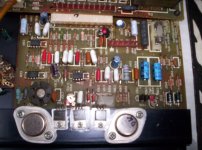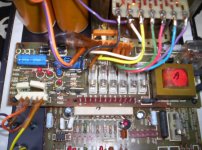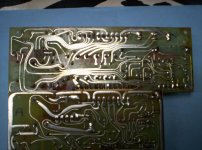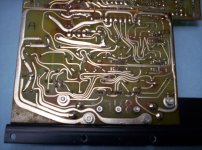I've tested the 2 TO-3's; all ok
Tested: TO-220's T-104, 105 and 108 all ok
tested; T-107; ok
diodes; D-202 and D204, ok.
I tried adjusting Bias using P-102 (C. Rep), and fuses #3 and 4 burned right away (they are 1.15amps each).
Amplifier is now a short, on my dim bulb tester...
I did not try adjusting my other amplifier!...
Tested: TO-220's T-104, 105 and 108 all ok
tested; T-107; ok
diodes; D-202 and D204, ok.
I tried adjusting Bias using P-102 (C. Rep), and fuses #3 and 4 burned right away (they are 1.15amps each).
Amplifier is now a short, on my dim bulb tester...
I did not try adjusting my other amplifier!...
I have no clue as to if these fuses were fast, standard, or slow blow as both of my amps have different types of fuses 🙁. It is not specified on the boards either...
Blurry and/or dark photos, no schematic, no information concerning supply and output voltages and currents, you might as well try to troubleshoot with a wet finger and in complete darkness .
It's not for nothing that nobody looked into this case.
🙄
It's not for nothing that nobody looked into this case.
🙄
Well, maybe i shouldn't have bought these, there are no schematics and/or service manuals for this version, anywhere and, people say that these amplifiers were un-reliable to start with... Un-lucky me.
Yep, agreed. When i finally have more time, i will compare the 2 amps,( one still works). Could excessive Bias, give me a glowing, 40 DBT bulb?, i just continues to glow, like there was a short transistor...
It could well be due to an excessive bias setting, though there are many more faults which can also cause abnormally high loads on the power supply. Since you already recapped it, it does seems likely that there was a deeper existing problem or perhaps you've just done some things wrong in that recapping process - maybe a reversed cap? a poor solder joint or a short caused there, perhaps higher capacitance combined with low ESR which blows the fuses?
It's also likely that a previous owner has already fiddled with anything and everything adjustable to try their luck at fixing problems too. That's not unusual behaviour but there are so many issues that you can only trace by wise measurements but now, the fuses will need replacing anyway. If they are quick blowing types, its usually obvious by being somewhat more complex than a simple, tinned wire inside. Generally, there will be an additional code letter added to the stamped marking on the end caps to make it clear. There are wikis on this topic - e.g. https://www.swe-check.com.au/pages/learn_fuse_markings.php)
It's also likely that a previous owner has already fiddled with anything and everything adjustable to try their luck at fixing problems too. That's not unusual behaviour but there are so many issues that you can only trace by wise measurements but now, the fuses will need replacing anyway. If they are quick blowing types, its usually obvious by being somewhat more complex than a simple, tinned wire inside. Generally, there will be an additional code letter added to the stamped marking on the end caps to make it clear. There are wikis on this topic - e.g. https://www.swe-check.com.au/pages/learn_fuse_markings.php)
- Home
- Amplifiers
- Solid State
- DBT glowing a lil longer then usual when turning on a servo amp...



